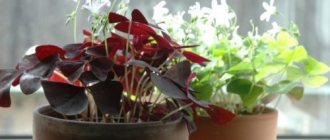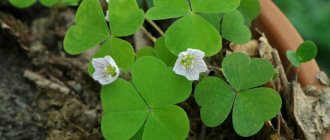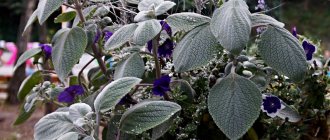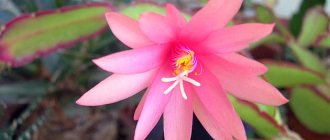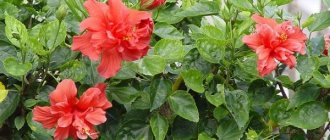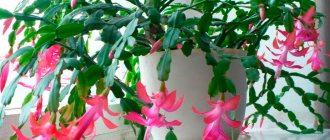Useful tips
- Are Decembrist's leaves turning red?
In winter, when it’s bitterly cold outside and everything is white with snow, when trees and bushes sleep in a snowy robe, and ruffled birds are diligently trying to get better shelter from the wind, it is at this moment that the wonderful winter flower Decembrist blooms.
This usually happens between November and December
. Hence the name of this flower, which colors the life of gardeners in the cold, winter cold with different summer colors.
Flower
This one is unpretentious
,
but in order for it to grow well and bloom profusely in winter, you need to know a few nuances about caring for this beautiful plant.
Varieties of Decembrist flower
Initially, only 2 varieties of Decembrist were widespread - with white and with red flowers. The emergence of new varieties, the range of which is regularly replenished, is the merit of breeders.
The most famous varieties:
Rousseliana
A bush characterized by lush flowering and a tendency to branch, up to 30 cm high with long meter-long shoots. The petals of tubular flowers look like bells with long stamens.
Truncated
Spreading bush with light green long shoots. Multi-tiered flowers are decorated with pointed petals and a cascade of stamens. Color varies from lilac to white.
Buckley
Bush up to 40 cm high with dark green fleshy shoots. Flowers start from 8 cm in size. Color depends on the variety.
More than a hundred Decembrist hybrids have been bred. They are united in a series, the differences between which are only in the shades and sizes of the flowers. The conditions for growing Decembrist do not change.
Description of the succulent
The Christmas cactus has erect and drooping stems that grow up to 15-30 cm in length; the leaves consist of 5-6 cm segments. Each segment has jagged edges. The stems are flat, fleshy, clearly divided into sections, at the ends of which flowers appear up to 10 centimeters long.
Flowers with curved perianth petals of varying lengths, arranged in 2 spaced rows, creating the impression of a short fragment of a garland. Flowers are white, red, pink, yellow.
The Schlumbergera cactus usually grows alone in a pot, but can be planted in a large container with other cacti.
Zygocactus belongs to the cactus family (lat. Cactaceae), but does not behave like a typical cactus. Decembrist has no thorns or spines, but thin dark bristles may appear at the top of its dark green, shiny, leaf-shaped shoots.
Decembrist belongs to the succulent family. Plants of this type are characterized by thick, fleshy stems that store water. Succulents owe their resistance to environmental conditions to their original forms. Although they take different forms, the structure of their leaves, shoots and roots does not differ. The fabrics allow water to accumulate, which protects against environmental damage during droughts. Zygocactus stores water in its stems, shoots and roots, thanks to which it can survive in very unfavorable conditions.
Reference. Succulents grow all over the world - in Europe, Asia, America. They include a diverse group of plants, from tiny aquatic species to giant woody desert cacti. Succulents love light soil with added sand. Growing and caring for succulents is undemanding; they are usually propagated by cuttings. All succulents are usually planted shallow in a pot. Most of the group consists of cacti. Cacti differ from other succulents in that they have growth cones and so-called halos, that is, covered with hairs or down, round or elongated places from which thorns, side shoots, and flowers grow.
Caring for the Decembrist at home
To grow a Decembrist flower, you need to know exactly what this exotic plant needs. On the one hand, it is unpretentious, despite its tropical origin. On the other hand, it is necessary to create favorable conditions for the plant to bloom every year.
Recommendations for growing Decembrist:
- ensure sufficiently high air humidity (by spraying);
- protect from direct sunlight, otherwise the shoots will turn red;
- do not use additional lighting, since the plant prefers short daylight hours;
- avoid waterlogging and drying out of the soil substrate;
- take it out onto the terrace in summer, place it in partial shade;
- protect the plant from drafts.
Let's talk in more detail about some of the features of growing Decembrist.
Lighting
Direct rays of the sun are pleasant for cacti. The Decembrist needs diffused light, but not a lack of lighting. A room with windows facing north is a good place to place a flower pot. He will also like the humidity of the kitchen and bathroom.
Watering
The frequency of watering depends on the stage of flower development. For irrigation, use settled water at room temperature. From October to January, when the period of budding and subsequent flowering begins, the plant needs abundant watering, but liquid should not be allowed to stagnate in the pan.
Humidity
Decembrist likes high humidity. For rapid growth and abundant flowering, regularly spray the plant or use a humidifier.
Temperature
The flower does not like temperature changes; it also does not like excessive heat and cold. The optimal temperature range is +15...+25 degrees with an air humidity of 75%. During budding, it is useful to carry out hardening on the balcony at a temperature of about +15 degrees.
Top dressing
Caring for and growing Decembrist at home cannot be imagined without regular feeding. A complex fertilizer for cacti is suitable for this purpose. Feeding is carried out according to the following scheme:
- From February to March, when the flower is resting, it is enough to just slightly moisten the soil. To prevent the soil substrate from drying out, the tray is lined with expanded clay and moss. No fertilizing is carried out during this period.
- From April until the end of summer, the Christmas tree enters the active growing season. At this time, it requires regular moderate watering. You can add ammonia to the water at the rate of 1 tsp. for 1 liter of water. Fertilizing is applied once every 2 weeks. The main components are NPK complex. The dosage of the drug intended for fertilizing home flowers is divided in half.
- In September, the plant is preparing to bloom, which means it’s time to limit watering, remembering to wet the moss in the tray to maintain optimal humidity. As soon as the buds appear, begin to intensively water and fertilize.
Transfer
Although the plant grows slowly, growing Decembrist does not exclude replanting the plant. If you buy a plant in a pot and there are roots sticking out of the drainage hole, replanting must be done immediately. If the roots are not visible, it can be postponed until the flower is 5 years old.
This is best done at the end of the flowering period. The roots of the plant are superficial and poorly developed, so a wide, shallow pot is suitable. In a container that is too spacious, the roots will actively grow to the detriment of flowering.
Transplanting an adult plant begins by filling the pot ⅓ full with drainage. The remaining ⅔ is occupied by compacted soil. The flower is moved from the old pot to the new one after thoroughly cleaning the roots from the old soil mixture. After this, all that remains is to carefully sprinkle the roots with soil and lightly water them. As the substrate settles, you can add a little more.
Trimming
Young plants do not require plucking (pruning). You can only remove buds that have bloomed. After flowering ends, the crown of adult bushes is formed. Knives are not used for this, but simply carefully remove faded, flaccid shoots and wilted buds with your hands.
Reproduction
Most often, propagation is carried out by cuttings, in rare cases by grafting onto succulents. In any case, shoots without diseases and damage are chosen for this. How to grow Decembrist from cuttings? You can immediately root them in the soil or place them in water first. In the second case, the process is accelerated.
From the rainforest to the windowsill
Decembrist is a popular plant belonging to the genus Schlumbergera (lat.). Until the early 90s it was part of the genus Zygokaktus, and this name can still be found. In fact, the correct name for this attractive and very popular plant is Schlumbergera trunctata. The name was given in honor of the Frenchman Frederic Schlumberger, who lived in the 19th century, a famous collector and cultivator of cacti. On the other hand, the plant owes the term “Decembrist” to its unusual winter flowering season.
People buy this flower as a New Year's decoration or gift. Zygocactus is a long-lived plant that grows for 10-20 years in an apartment. However, you need to know how to grow it so that it maintains a festive mood for many years.
The Christmas cactus originates from Brazil. The plant is an epiphyte, that is, it grows on the crowns of tropical trees. Decembrist shoots can hang freely from trees up to several tens of centimeters! Sometimes this flower also grows on rocks covered with vegetation (in rock cavities). It was supposedly a garden plant once cultivated by local tribes.
Zygocactus came to Europe in the 19th century and almost immediately became a favorite flower. After a period of slight oblivion, this plant returned to the windowsills. In winter it beautifully decorates apartments with bright flowers, and in summer it grows on balconies, terraces or even directly on flower beds.
Diseases and pests
The flower is immune to most pests and diseases, unless, of course, it is healthy. But against the background of excess or deficiency of watering, as well as in the case of proximity to diseased plants, the Decembrist’s immunity decreases.
Preparations that will help in pest control:
- spider mites - “Fitoverm”, “Vertimek”, “Aktofit”;
- mealybug - “Aktara”, “Konfidor”;
- scale insects - insecticides.
Temperature
Since zygocactus comes from the tropics, it loves air humidity and tolerates high temperatures. Therefore, tolerance ranges from 2°C to 40°C. It is unlikely that there will be such temperature changes in room mode.
The optimal temperature in winter and spring is 12-16°C, in summer – 18-26°C, during flowering 16-18°C. By showering, the leaves will not only be saturated with moisture, but the dust will also be washed away, and in the summer it will help to cool down. This procedure cannot be carried out only during flowering.
Advantages and disadvantages
Decembrist is a houseplant that pleases its owner with bright blooms in winter. When purchasing a flower, which is also called Christmas tree, zygocactus and schlumberger, it is important to familiarize yourself with the care features. If you do not provide the Decembrist with conditions favorable for growth and development and proper care, there is no point in waiting for flowering.
The length of bushes with branched stems reaches 40 cm. In order for the bush to grow evenly, it should be systematically turned to the light in different directions. The main advantages of this indoor plant include:
- ease of care;
- abundant flowering;
- the possibility of reproduction by pinching off branches from 3-4 segments without flowers and placing them in a container filled with water.
The disadvantage of Christmas is considered to be susceptibility to fungal diseases such as late blight, phytium and fusarium.
Reproduction
Schlumbergera is propagated in two ways - cuttings and seeds.
Propagation by cuttings
The preferred time for reproduction is spring and summer. The method of propagation by cuttings is very simple and unpretentious.
You just need to unscrew a leaf with two or three segments from the main plant, deepen it into moist soil, cover it with film, make holes in it for ventilation and place it in a warm, bright place. To accelerate the formation of roots, you can use rootin or zircon.
As soon as a new segment begins to appear, the cuttings have taken root and are ready to be transplanted into a pot. You can propagate the plant differently by placing the cuttings in a glass of water and waiting for the roots to appear before transplanting them to a permanent place of growth.
Propagation by seeds
In the wild, Schlumbergera flowers are pollinated by insects, after which an ovary is formed and a pink, pear-shaped fruit about two centimeters in length grows. This edible berry stays on the segment until the next flowering, gradually ripening. It tastes sour, birds eat it, and spread the seeds around with excrement.
No matter how good the care is, you cannot get seeds in indoor conditions. Therefore, purchased seeds are used. Having planted them in moist soil and covered them with a film with holes for ventilation, wait for them to sprout. The period varies from 20 days to several months. When shoots appear, wait until they get stronger, and then transplant them into pots.
Decembrist's flaccid leaves: causes, prevention, treatment
Limp leaves on a Christmas tree indicate the death of the root system or the plant being infected by a fungal disease. As a rule, such a nuisance most often occurs against the background of fusarium, phytium and late blight. Before the disease has time to affect the root system, there is a chance to save the plant by treating it with one of the following drugs:
- "Fitosporin-M";
- "Maksim";
- "Topaz".
After processing, the Christmas tree needs to be transplanted into another container. Planting is carried out in new, uncontaminated soil.
Note! If the root system of the Decembrist is damaged, it will no longer be possible to save the flower. In this case, it is more advisable to take cuttings from the plant and grow a new one from its segments.
The soil
The soil can be purchased either at a flower shop - soil for succulents (plants with fleshy stems), or you can make it yourself: mix equal parts compost, turf soil, sand, add vermiculite and ash.
Decembrist leaves turn red: how to fix it
Often the foliage of a home Decembrist turns red. The reasons for changes in the color of green mass may be the following factors:
- The room lighting is too bright. Christmas tree prefers shaded areas, so flower pots should be placed on east or west windows. During the hot season, it is better to move the plants to the north side. On sunny days, flower growers advise shading the plant. If you do not follow the described recommendations for caring for the Decembrist, the foliage will begin to turn red and purple.
- Growth of new segments on foliage. In early spring, the crop begins to grow new segments. During this period, the tips acquire a reddish tint. Don't worry: the leaves will turn green again as they grow.
- Violation of the fertilizing schedule or the use of unsuitable fertilizers. In order for the Christmas tree to develop well, care should be taken to provide the plant with nutrients in a timely manner. Experienced gardeners recommend adding cacti fertilizers to the soil from October to January, which contain a significant percentage of nitrogen, phosphorus, magnesium and potassium. During the phase of active shoot growth, it is worth fertilizing the plants with mineral fertilizers in combination with organic matter.
- Often the cause of reddening of leaves is excessive watering. Decembrist does not like waterlogged soil, so the flower should be watered regularly, but not abundantly. Constantly wet soil will cause rotting of the root system. The foliage will begin to wither and turn red. To prevent the death of the crop, allow the soil to dry thoroughly. After this, you can transplant the plant into new soil, not forgetting to rinse the root system and remove the rotten part.
Common problems
*If you find brown spots on the leaves, the plant is affected by scale insects.
*If the plant stubbornly refuses to bloom, the room temperature is probably below 10 degrees.
*If Decembrist
dropped the upper segments of the shoots or the buds themselves - most likely the plant is experiencing drought or vice versa, waterlogging of the soil, as well as a change of location during the plant’s ovary. This can also happen if the plant is attacked by pests.
*If you find pale and sluggish shoots on a plant, then the likely cause is irregular watering, too much sun and pests.
*You saw light spots on the shoots of the plant - the plant is infected or there is an excess of light.
How to choose a Decembrist when purchasing
When buying Decembrist in a store, you should pay attention to the appearance of the flower, as well as the quality of the soil in which it grows. The substrate should be slightly moist, and the indoor plant itself should not show signs of rot.
Despite the fact that the flowering plant looks much more beautiful, it is worth choosing a specimen, the bulk of the flowers of which are not fully revealed. The fact is that, once in home conditions, the Christmas tree sheds the bulk of its flowers. This is completely normal, so don't be upset.
It is not advisable to replant immediately after purchase. However, if the procedure cannot be postponed, you should carefully transfer the plant into a larger pot. The earthen lump cannot be disturbed in this case.
By providing proper care for the Decembrist, you can create ideal conditions for the growth and development of the plant. With its lush green foliage and vibrant, long-lasting blooms, this indoor plant will be a real addition to any room during the cold winter months.
Top dressing
Buy fertilizer for a given crop; if you don’t have one, then it will work for ordinary flowers, only in liquid form. In this case, feed not as written in the instructions, but diluted twice.
Feed in the spring - once a month, in the summer, during the formation of leaves - twice a month, in the fall, during preparation for budding - stop feeding. Instead, it is better to spray with some fungicide to prevent the formation of fungal diseases.
Following all the recommendations correctly:
- in the fall, stop frequent watering and fertilizing;
- three months before flowering, place in a cool, shaded place;
- in December, place in a well-lit place and start watering abundantly,
The Christmas lover should feel the signal and give color just in time for the “New Year”.
Secrets of lush flowering
The secrets are simple, but it’s worth learning the intricacies of caring for a flower. Then photos of exotic Decembrist flowers will delight your loved ones.
When should zygocactus bloom?
In nature, the Christmas cactus can bloom from October to March, depending on the rainy season. The Decembrist is actively preparing for the formation of buds after it has accumulated enough moisture that tropical showers bring.
Since such a climate is not typical for our latitudes, in the summer the plant is watered more abundantly so that when cold weather arrives it has enough strength to form flower buds.
Normally, the Decembrist blooms once a year, because preparing for the laying of future inflorescences requires a lot of resources and depletes it. However, the plant can delight the owner with fresh buds several times between November and February, if good conditions have been created for it.
Links
- Media files on Wikimedia Commons
- Leaf cacti: epiphyllum and zygocactus
- Information about the different types of Schlumbergera (n.d.) (Date of access: November 23, 2009)
- The Schlumbergera flower is blooming. Video accelerated 1000 times
- Schlumbergera Hybrids. Schlumbergera hybrids (inaccessible link)
| Dictionaries and encyclopedias |
|
| Taxonomy |
|
Pollination
The peculiar structure of Decembrist flowers explains the plant’s inability to self-pollinate. The elongated flask-shaped shape of the flower consists of several joints strung on top of each other; a pistil emerges from the tips of the last flower, which is framed by stamens. In nature, zygocactus is cross-pollinated with the help of tropical hummingbirds. For this reason, Decembrist has an elongated stem shape; the plant’s homeland predetermines cross-pollination by birds and insects. After pollination, after some time, oval red fruits are formed at the ends of the branches.
Priming
The soil must allow moisture and air to pass through. If you make the soil yourself, the base is sand and leaf humus in equal proportions.
You can add a little charcoal or peat. A no-fuss option is a universal primer. The soil is not suitable for cacti (excess peat).
Fertilizer
When caring for a plant, you need to know what to fertilize the Decembrist (flower). The homeland of the plant, where zygocacti lead a parasitic lifestyle, taking root on the trunks of tropical plants, provides the flowers with the necessary nutrients from the wood. Therefore, the plant is very unpretentious; regular cactus fertilizer is enough for it, which should be diluted by two quarters with water so as not to burn the delicate roots of the Decembrist.
Notes
- For the convention of indicating the class of dicotyledons as a superior taxon for the group of plants described in this article, see the section “APG Systems” of the article “Dicotyledons”.
- ↑ 1 2
Information about the genus
Schlumbergera
Index Nominum Genericorum
database of the International Association for Plant Taxonomy (IAPT). (Accessed: January 29, 2018) - ↑ 123456
Botany. Encyclopedia “All the Plants of the World”: Trans. from English = Botanica / ed. D. Grigoriev and others - M.: Könemann, 2006 (Russian edition). - P. 829. - 1020 p. — ISBN 3-8331-1621-8. - According to the GRIN
(see Links section). - ↑ 123456
Udalova, 1983. - RT Poole, LS Osborne and AR Chase University of Florida, IFAS Central Florida Research and Education Center - Apopka 2807 Binion Road., Apopka, FL 32703-8504.
Holiday Cactus Production Guide
(unspecified)
. - https://www.invasive.org/browse/detail.cfm?imgnum=5372598 (undefined)
. - https://negreenhouseupdate.info/photos/schlumbergera-drechslera-leaf-spot-and-stem-rot (unspecified)
(inaccessible link). Retrieved March 14, 2016. Archived October 25, 2022. - https://www.invasive.org/browse/detail.cfm?imgnum=5373286 (undefined)
. - List of species of the genus Schlumbergera (inaccessible link) according to the GRIN
(English) (Access date: November 12, 2009)


